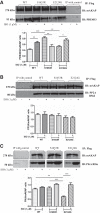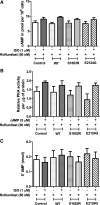Human muscle-specific A-kinase anchoring protein polymorphisms modulate the susceptibility to cardiovascular diseases by altering cAMP/PKA signaling
- PMID: 29600899
- PMCID: PMC6087776
- DOI: 10.1152/ajpheart.00034.2018
Human muscle-specific A-kinase anchoring protein polymorphisms modulate the susceptibility to cardiovascular diseases by altering cAMP/PKA signaling
Erratum in
-
Corrigendum.Am J Physiol Heart Circ Physiol. 2019 Feb 1;316(2):H432. doi: 10.1152/ajpheart.zh4-2504-corr.2019. Am J Physiol Heart Circ Physiol. 2019. PMID: 30715904 Free PMC article. No abstract available.
Abstract
One of the crucial cardiac signaling pathways is cAMP-mediated PKA signal transduction, which is regulated by a family of scaffolding proteins, i.e., A-kinase anchoring proteins (AKAPs). Muscle-specific AKAP (mAKAP) partly regulates cardiac cAMP/PKA signaling by binding to PKA and phosphodiesterase 4D3 (PDE4D3), among other proteins, and plays a central role in modulating cardiac remodeling. Moreover, genetics plays an incomparable role in modifying the risk of cardiovascular diseases (CVDs). Single-nucleotide polymorphisms (SNPs) in various proteins have especially been shown to predispose individuals to CVDs. Hence, we hypothesized that human mAKAP polymorphisms found in humans with CVDs alter the cAMP/PKA pathway, influencing the susceptibility of individuals to CVDs. Our computational analyses revealed two mAKAP SNPs found in cardiac disease-related patients with the highest predicted deleterious effects, Ser 1653 Arg (S1653R) and Glu 2124 Gly (E2124G). Coimmunoprecipitation data in human embryonic kidney-293T cells showed that the S1653R SNP, present in the PDE4D3-binding domain of mAKAP, changed the binding of PDE4D3 to mAKAP and that the E2124G SNP, flanking the 3'-PKA binding domain, changed the binding of PKA before and after stimulation with isoproterenol. These SNPs significantly altered intracellular cAMP levels, global PKA activity, and cytosolic PDE activity compared with the wild type before and after isoproterenol stimulation. PKA-mediated phosphorylation of pathological markers was found to be upregulated after cell stimulation in both mutants. In conclusion, human mAKAP polymorphisms may influence the propensity of developing CVDs by affecting cAMP/PKA signaling, supporting the clinical significance of PKA-mAKAP-PDE4D3 interactions. NEW & NOTEWORTHY We found that single-nucleotide polymorphisms in muscle-specific A-kinase anchoring protein found in human patients with cardiovascular diseases significantly affect the cAMP/PKA signaling pathway. Our results showed, for the first time, that human muscle-specific A-kinase anchoring protein polymorphisms might alter the susceptibility of individuals to develop cardiovascular diseases with known underlying molecular mechanisms.
Figures








Comment in
-
Form follows function: polymorphisms in mAKAP alter cardiac cAMP/PKA signaling.Am J Physiol Heart Circ Physiol. 2018 Sep 1;315(3):H626-H628. doi: 10.1152/ajpheart.00248.2018. Epub 2018 May 4. Am J Physiol Heart Circ Physiol. 2018. PMID: 29727216 Free PMC article. No abstract available.
Similar articles
-
Protein kinase A and phosphodiesterase-4D3 binding to coding polymorphisms of cardiac muscle anchoring protein (mAKAP).J Mol Biol. 2013 Sep 23;425(18):3277-88. doi: 10.1016/j.jmb.2013.06.014. Epub 2013 Jun 25. J Mol Biol. 2013. PMID: 23806656 Free PMC article.
-
cAMP-stimulated protein phosphatase 2A activity associated with muscle A kinase-anchoring protein (mAKAP) signaling complexes inhibits the phosphorylation and activity of the cAMP-specific phosphodiesterase PDE4D3.J Biol Chem. 2010 Apr 9;285(15):11078-86. doi: 10.1074/jbc.M109.034868. Epub 2010 Jan 27. J Biol Chem. 2010. PMID: 20106966 Free PMC article.
-
PKA-phosphorylation of PDE4D3 facilitates recruitment of the mAKAP signalling complex.Biochem J. 2004 Aug 1;381(Pt 3):587-92. doi: 10.1042/BJ20040846. Biochem J. 2004. PMID: 15182229 Free PMC article.
-
Compartmentalization role of A-kinase anchoring proteins (AKAPs) in mediating protein kinase A (PKA) signaling and cardiomyocyte hypertrophy.Int J Mol Sci. 2014 Dec 24;16(1):218-29. doi: 10.3390/ijms16010218. Int J Mol Sci. 2014. PMID: 25547489 Free PMC article. Review.
-
The mAKAP signaling complex: integration of cAMP, calcium, and MAP kinase signaling pathways.Eur J Cell Biol. 2006 Jul;85(7):593-602. doi: 10.1016/j.ejcb.2006.01.007. Epub 2006 Feb 7. Eur J Cell Biol. 2006. PMID: 16460834 Review.
Cited by
-
Cannabinoids Alleviate the LPS-Induced Cytokine Storm via Attenuating NLRP3 Inflammasome Signaling and TYK2-Mediated STAT3 Signaling Pathways In Vitro.Cells. 2022 Apr 20;11(9):1391. doi: 10.3390/cells11091391. Cells. 2022. PMID: 35563697 Free PMC article.
-
Polymorphisms/Mutations in A-Kinase Anchoring Proteins (AKAPs): Role in the Cardiovascular System.J Cardiovasc Dev Dis. 2018 Jan 25;5(1):7. doi: 10.3390/jcdd5010007. J Cardiovasc Dev Dis. 2018. PMID: 29370121 Free PMC article. Review.
-
Nanodomain cAMP signaling in cardiac pathophysiology: potential for developing targeted therapeutic interventions.Physiol Rev. 2025 Apr 1;105(2):541-591. doi: 10.1152/physrev.00013.2024. Epub 2024 Aug 8. Physiol Rev. 2025. PMID: 39115424 Free PMC article. Review.
-
Dynamic Regulation of Cysteine Oxidation and Phosphorylation in Myocardial Ischemia-Reperfusion Injury.Cells. 2021 Sep 11;10(9):2388. doi: 10.3390/cells10092388. Cells. 2021. PMID: 34572037 Free PMC article. Review.
-
mAKAPβ signalosomes - A nodal regulator of gene transcription associated with pathological cardiac remodeling.Cell Signal. 2019 Nov;63:109357. doi: 10.1016/j.cellsig.2019.109357. Epub 2019 Jul 9. Cell Signal. 2019. PMID: 31299211 Free PMC article. Review.
References
-
- Bidulescu A, Liu J, Musani SK, Fox ER, Samdarshi TE, Sarpong DF, Vaccarino V, Wilson PW, Arnett DK, Din-Dzietham R, Taylor HA, Gibbons GH. Association of adiponectin with left ventricular mass in blacks: the Jackson Heart Study. Circ Heart Fail 4: 747–753, 2011. doi: 10.1161/CIRCHEARTFAILURE.110.959742. - DOI - PMC - PubMed
Publication types
MeSH terms
Substances
Grants and funding
LinkOut - more resources
Full Text Sources
Other Literature Sources
Molecular Biology Databases
Research Materials

